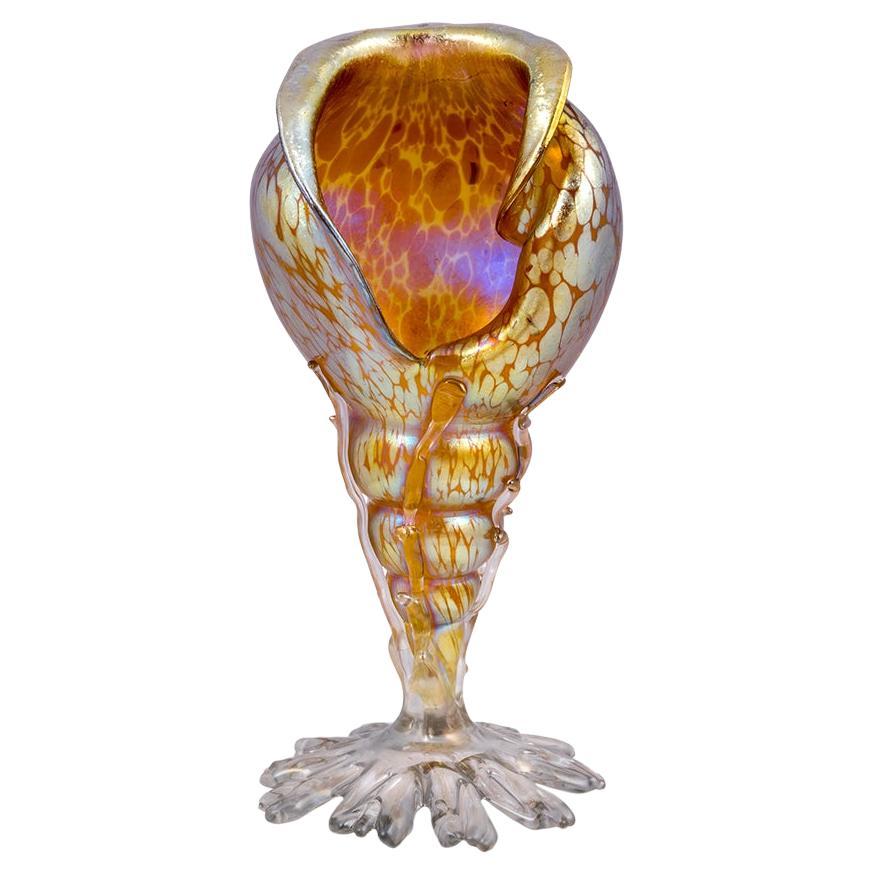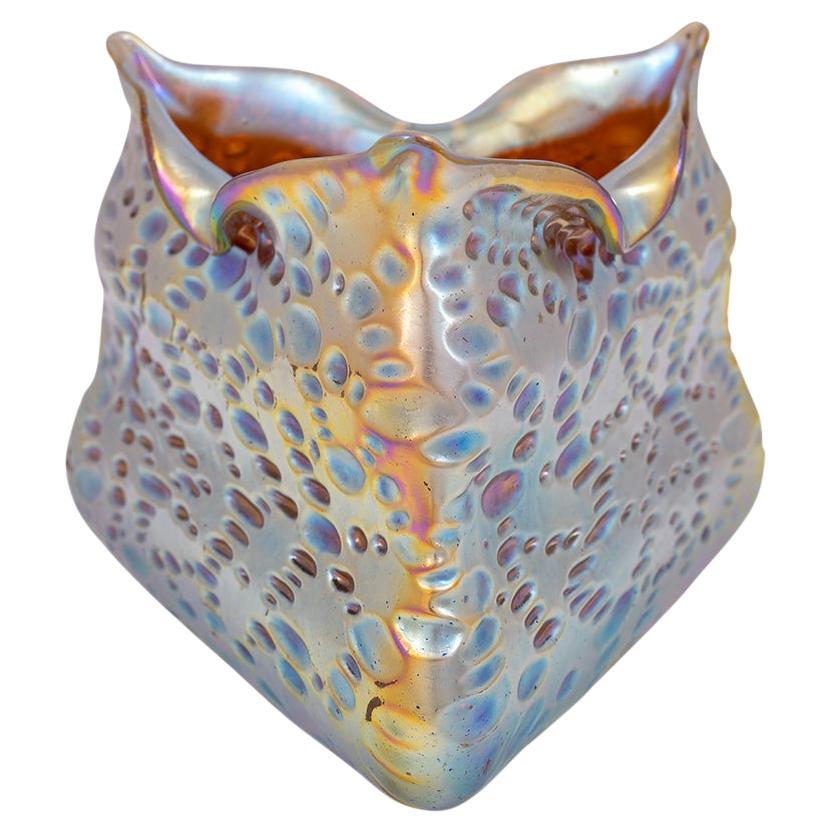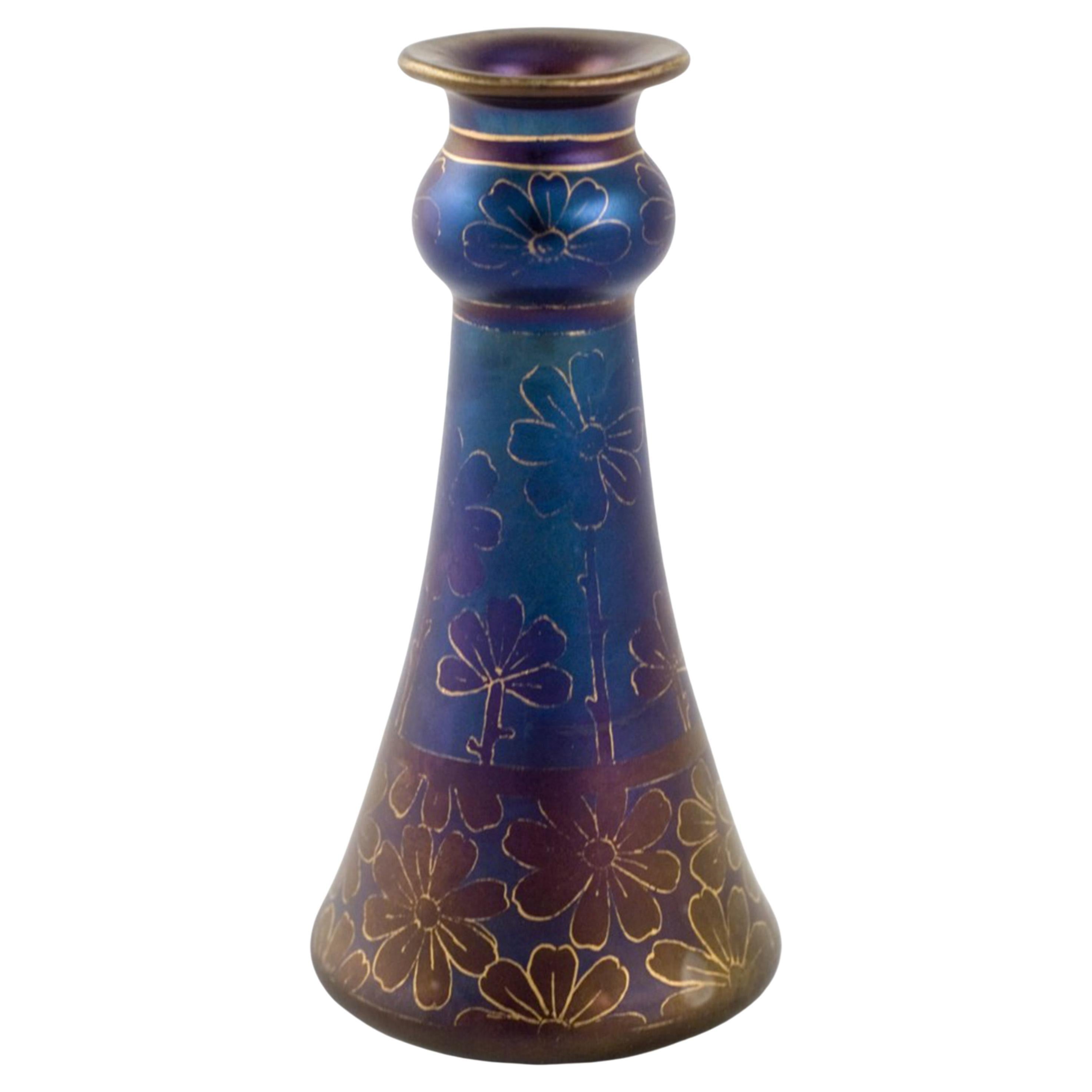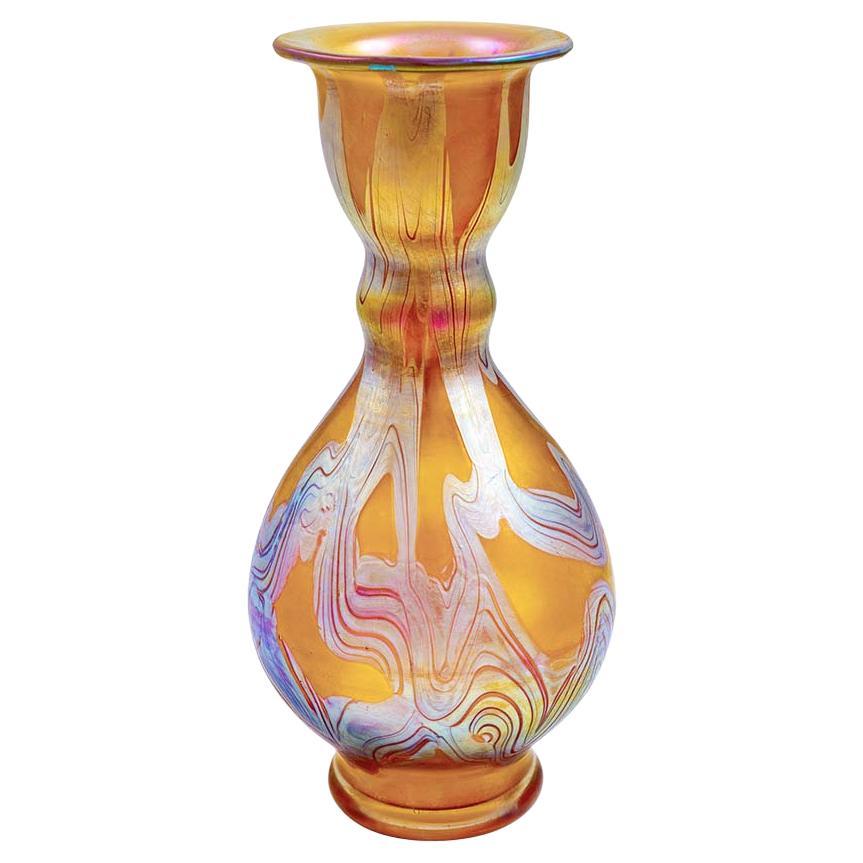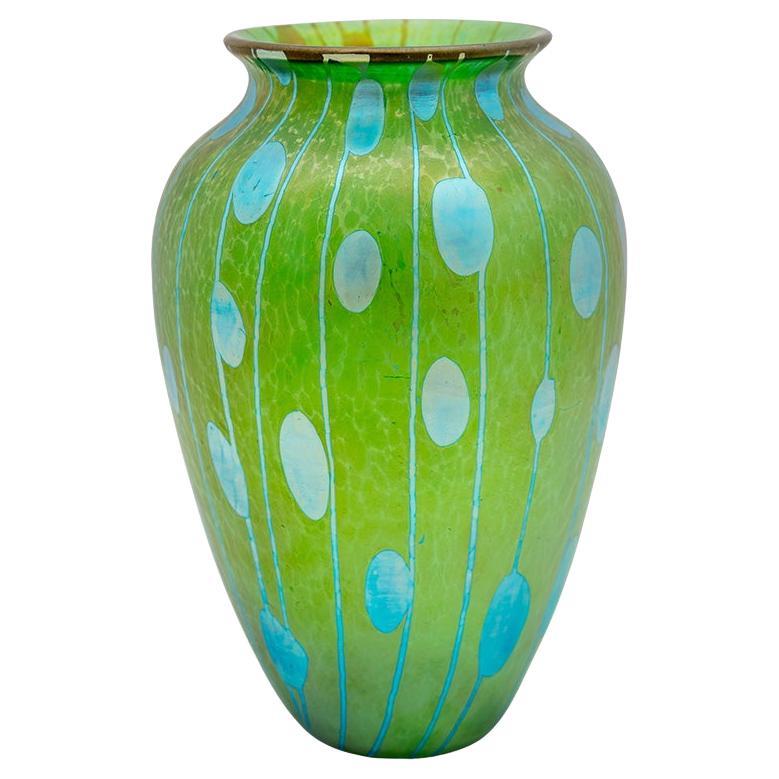Items Similar to Glass Plate Loetz Iridescent Orange Purple Pink Blue, circa 1900
Want more images or videos?
Request additional images or videos from the seller
1 of 8
Glass Plate Loetz Iridescent Orange Purple Pink Blue, circa 1900
About the Item
Austrian Jugendstil glass plate manufactured by Johann Loetz Witwe unidentified decoration, circa 1900
A special feature of the production line for the World Exhibition in Paris in 1900 were the designs of plates. With these objects, Loetz was not only able to demonstrate the great skills of his craftsmen and the power of the designers, but they were also a direct Challenge to the products of Louis Comfort Tiffany from America. Although Franz Hofstötter created highly sought-after works of art with these pieces, the technical effort was so great that these objects were no longer produced after 1900.
Signed with "Loetz/Austria".
- Creator:Loetz Glass (Manufacturer)
- Dimensions:Height: 1.78 in (4.5 cm)Diameter: 12.41 in (31.5 cm)
- Style:Jugendstil (Of the Period)
- Materials and Techniques:
- Place of Origin:
- Period:
- Date of Manufacture:1900
- Condition:Wear consistent with age and use.
- Seller Location:Klosterneuburg, AT
- Reference Number:
About the Seller
5.0
Vetted Seller
These experienced sellers undergo a comprehensive evaluation by our team of in-house experts.
Established in 2013
1stDibs seller since 2021
13 sales on 1stDibs
Typical response time: <1 hour
- ShippingRetrieving quote...Ships From: Klosterneuburg, Austria
- Return PolicyA return for this item may be initiated within 14 days of delivery.
More From This SellerView All
- Glass Vase Loetz with Drop Applications Blue Orange Iridescent, circa 1901By Loetz GlassLocated in Klosterneuburg, ATAustrian Jugendstil glass vase by Johann Loetz Witwe circa 1901 Phenomen Genre 1/78 decoration The vase pictured here, with its striking yet delicate form encased in remarkable "...Category
Early 20th Century Austrian Jugendstil Glass
MaterialsGlass
- Conch Shell Glass Vase Iridescent Handmade Loetz Austria Jugendstil, circa, 1900By Loetz GlassLocated in Klosterneuburg, ATConch shell glass vase handmade by Johann Loetz Witwe Austria/Bohemia Jugendstil circa 1902 "Candia Papillon" Decoration. The extravagant Candia Papillon decor lends a special brilliance to the shell shape of this collectible. The iridescent quality of this decoration not only encompasses the outside of the intricately applied silver crumbled dots, but extends into the interior of the glass shell. A characteristic of this scroll vase...Category
Antique Early 1900s Austrian Jugendstil Vases
MaterialsArt Glass, Blown Glass
- Bohemian Vase Loetz circa 1902 Iridescent GlassBy Loetz GlassLocated in Klosterneuburg, ATBohemian glass vase, manufactured by Johann Loetz Witwe, Candia Diaspora decoration, ca. 1902, Viennese Art Nouveau, Jugendstil Technique and material: glass, mould-blown and freefo...Category
Antique Early 1900s Austrian Jugendstil Glass
MaterialsArt Glass, Blown Glass
- Small Vase Loetz Blue Purple Gold Flowers circa 1900 Austrian JugendstilBy Loetz GlassLocated in Klosterneuburg, ATSmall Vase Johann Loetz Witwe blue purple flowers freehand and reduced blown glass I/116 decoration colored with etching ink and gold ca. 1900 marked remains of adhesive label Thi...Category
Antique Early 1900s Austrian Jugendstil Glass
MaterialsGlass, Blown Glass
- Vase Iridescent Glass Johann Loetz Witwe Austrian Jugendstil Orange SilverBy Loetz GlassLocated in Klosterneuburg, ATVase iridescent glass Johann Loetz Witwe Austrian Jugendstil "PG 7773" decoration In the 1890s, the Loetz company tried to break with the convention of the regional glass production...Category
Antique 1890s Austrian Jugendstil Glass
MaterialsGlass
- Bohemian Glass Vase Loetz Koloman Moser circa 1900 Blue GreenBy Koloman Moser, Loetz GlassLocated in Klosterneuburg, ATBohemian glass vase, manufactured by Johann Loetz Witwe, Flecken und Streifen decoration, ca. 1900, Green, Blue, Viennese Art Nouveau, Jugendstil, Art Deco, art glass, iridescent gla...Category
Antique Early 1900s Austrian Jugendstil Glass
MaterialsGlass
You May Also Like
- Loetz Vesuvian Candia Iridescent Glass Vase with TadpolesBy Loetz GlassLocated in Bishop's Stortford, HertfordshireStylish Bohemian Vesuvian Candia iridescent glass vase with tadpoles by Johann Loetz Witwe and dating from around 1901. The simply shaped wide v...Category
Antique Early 1900s Austrian Art Nouveau Vases
MaterialsBlown Glass
- Vintage Pink Iridescent Etched Blown Glass Vase "Diaspora" by LoetzBy Loetz GlassLocated in Bresso, LombardyMade in pink etched blown glass with iridescent and material effects. It is a vintage item, therefore it might show slight traces of use, but it can be considered as in very good or...Category
Vintage 1920s European Art Deco Vases
MaterialsBlown Glass
- Vase Loetz Widow Amber Papillon Iridescent Pewter Mounting Silver PlatedBy Loetz GlassLocated in Vienna, ATGorgeous Art Nouveau Vase of very rare shape Made by Loetz (Lötz) Widow Klostermuehle Bohemia, circa 1900 Decor: amber-orange colored type of Papillon Form: round as well as bellied body with scalloped mouth and silver plated mounting Gorgeous glass item with vertical ribbings on surface, running from edge of mouth to area below. This vase's mouth is of irregular form, having extremely scalloped edge causing this vase's very special appearance. The decor is quite rare type of Papillon - amber-orange shaded and blue-golden shining due to its stunning iridescence ! Finally, this vase's round hollow body is attached to high holder which seems to have been manufactured especially for this glass item: It is a silver plated mounting made of pewter: This one has three arms at top area, holding the vase / the Stand is three-sided, excellently decorated with floral ornaments of reticulated type - most probably these are lady slipper orchids...Category
Antique Early 1900s Austrian Art Nouveau Glass
MaterialsSilver Plate, Pewter
- Art Nouveau Loetz Iridescent Glass Vase with Silver OverlayBy Loetz GlassLocated in Buenos Aires, OlivosArt Nouveau glass vase with engraved silver overlay by historic Czech maker Loetz.Category
Early 20th Century Austrian Art Nouveau Vases
MaterialsSterling Silver
- Loetz Attributed Peacock Feather Iridescent Miniature Art Glass VaseBy Loetz GlassLocated in Bishop's Stortford, HertfordshireAn exceptional quality Art Nouveau miniature iridescent glass vase, possibly Loetz and dating from the early 20th century. This heavily made amethyst glass vase is exquisitely decora...Category
Antique Early 1900s Austrian Art Nouveau Vases
MaterialsBlown Glass
- Vase Loetz , Style : Art Nouveau , Bohemia, circa 1900By Loetz GlassLocated in Ciudad Autónoma Buenos Aires, CLoetz The glass factory, originally founded in 1836 by Johann Baptist Eisner, was taken over. Loetz was the premier Bohemian glass works during this period. It was located in Klostermühle, near Rejštejn in the Sušice district in South-West Bohemia, which belonged to the Austro-Hungarian Empire until 1918. Susanna Loetz, widow of Glass entrepreneur Johann Loetz in 1852. She renamed the company "Glasfabrik Johann Loetz Witwe", a name that was retained until all activities were stopped in 1947. In 1879 it passed to Max Ritter von Spaun. Under his guidance, together with director Eduard Prochaska, the glassworks flourished as never before and enjoyed its most successful period. Von Spaun and Prochaska concentrated on the development of innovative glass types and new production techniques. Their first successful speciality was a glass type simulating semiprecious stones. It is often called "Marmoriertes Glas" ("marbled glass"). The range contained Onyx (red/brown), Karneol (red/pink) and later Malachit (green). It was introduced in the second half of the 1880's. From the same period dates the Octopus glass, of which the decor resembles the tentacles of a cephalopod. The production of Marmorier-tes Glas was resumed in 1906, in different colours like yellow and white. Octopus, 1885-1890, 1885-1890, unknown, an Malachit, 1885-1890, unknown, The master glass-blowers of Klostermühle had already carried out experiments with iridescence in the first half of the 1890's, and they produced the Olympia, a classically inspired olive green type, in 1896. Similar, in variants of creta green, bronce or Olympia and averse to any redundant decoration was the Glatt decor. It highly contrasted with the more elaborate finishes of that time, but it constitutes a part of the production with a deep sense for taste and quality. Most of the pieces shown in the "Glatt" decors were manufactured for Max Emmanuel in London. The glatt decor remained in use for many years. The Chiné decor had thin glass threads spun around the body in irregular patterns. It is not to be confused with the type of glass that was produced by Kralik. Loetz "Chiné" came in clear, opal, green and pink, Kralik "Chiné" in dark purple. The logical sequel to Chiné was the Pampas decor, green or cobalt blue, in which the threads almost disappeared in the surface, with iridised parts in between. Around the same time the dotted Papillon decor was introduced. The beautiful silver spots were employed on a wide array of models and quite effective on the gooseneck (water sprinkler) and sea shell...Category
Antique Early 1900s Austrian Art Nouveau Glass
MaterialsArt Glass
Recently Viewed
View AllMore Ways To Browse
Pierre D'Avesn On Sale
Libbeys Silver Leaf Glass
Lobmeyr Decanter
Michael Boehm
Mikko Helander
Orange Water Goblets
Orrefors Carafe
Pressed Glass Goblets
Tiffany Cordial
Antique Amberina Glass
Antique Amberina
Antique Pressed Glass Goblets
Axel Enoch Boman
Axel Enoch
Baccarat Parrot
Biedermeier Beaker
Blenko Blue Pitcher
Fenton Blue Hobnail

